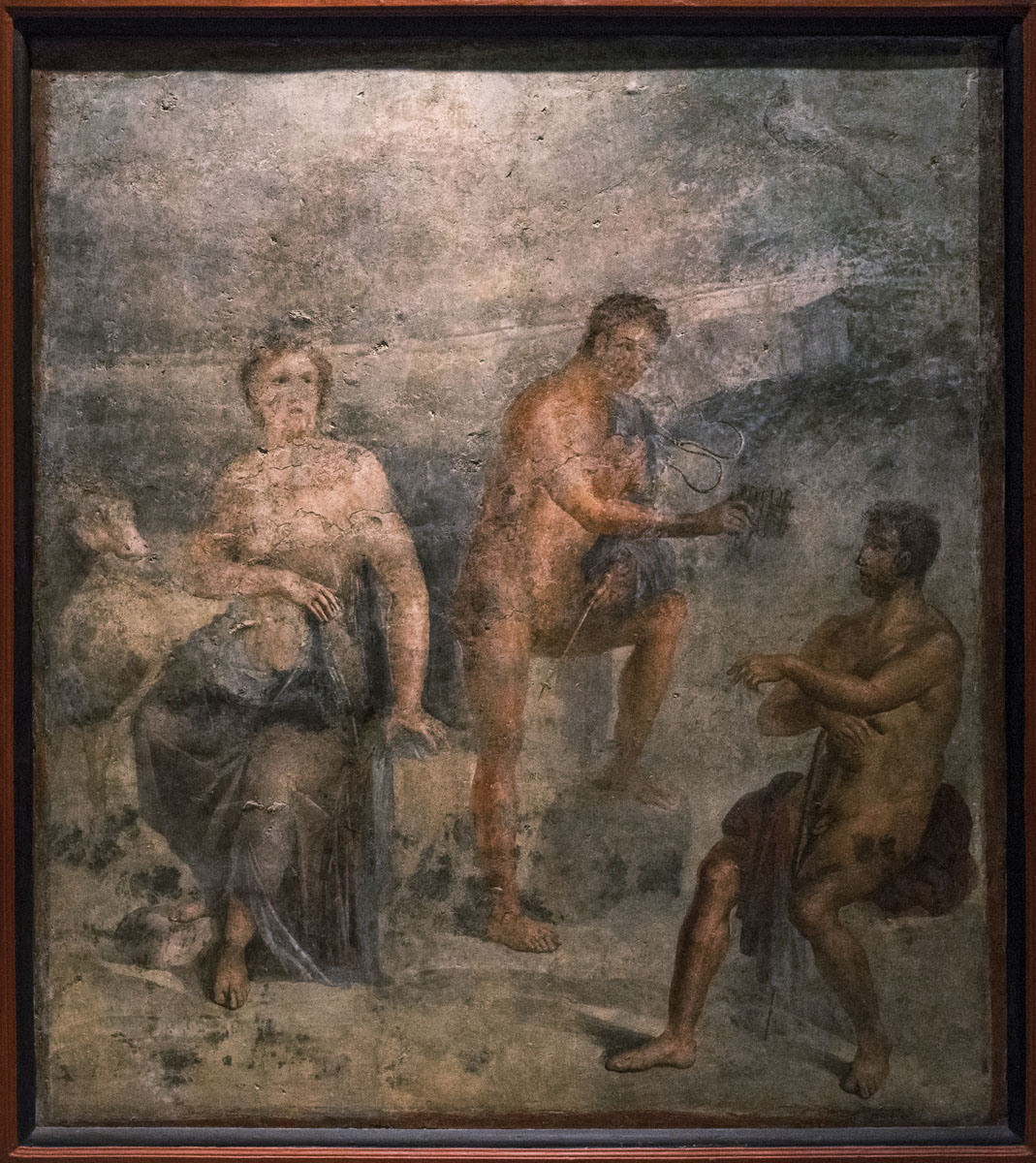
60—79 CE. Inv. No. 9548.Naples, National Archaeological MuseumPhoto by Egisto Sani
Io, Argus and Hermes.
60—79 CE.
Naples, National Archaeological Museum
(Napoli, Museo archeologico nazionale).
 135. Pompei. Isistempel (XXXII). Museo nazionale in Neapel, I, 37. B. 1,57. H. 1,68.
135. Pompei. Isistempel (XXXII). Museo nazionale in Neapel, I, 37. B. 1,57. H. 1,68.
Io sitzt l. auf einem Steine, an der Stirn die Kuhhörner, ein Band um das Haar, die L. auf ihren Sitz stützend, mit der K. einen Zipfel des gelben Mantels haltend, welcher ihren Körper von den Hüften abwärts bedeckt. Neben ihr steht eine Kuh. Io gegenüber sitzt Argos, ein kräftiger Jüngling, eine röthliche Chlamys über den Schenkeln, die Arme auf einen Stab stützend, den er zwischen die Schenkel gestellt hält. Ihm zugewendet steht Hermes, mit Flügeln an den Fussknöcheln, Sandalen an den Füssen, den Caduceus in der L., eine grüne Chlamys um den l. Arm, welchen er auf den erhöht gestellten l. Schenkel stützt, und reicht ihm mit der R. eine Syrinx.
Pompeianarum antiquitatum historia quam ex cod. mss. et a schedis diurnisque quae in publicis aut privatis bibliothecis servantur nunc primuin collegit Ios. Fiorelli I. II. III, 1 Neap. 1860—
Winckelmann Gesch. d. Kunst Buch 7 K. 3 § 26.
Annali dell’ Jnstituto di corrispondenza archeologica. 1865 p. 156.
The painting represents the themes of the imprisonment and the liberation of Io. The young woman is represented on the left, seated on a stool. Her face is characterized by two small horns on the forehead: they identify Io metamorphosed in a heifer. Even the cow painted behind her confirms her identity. Hermes is standing in the middle of the scene, with his left foot resting on a rock. The god is portrayed in the act of offering a “syrinx” — panpipes — to Argos. Here the naked giant is seated and holds a “pedum”. This attribute characterizes Argos as a shepherd.
Hermes, disguised as a shepherd, complete with panpipes, strikes up a conversation with Argus and entertains him with stories, during which more and more of the guard’s eyes close in sleepiness. When Argos wants to know the origin of the panpipes, Mercury starts to tell the story of Syrinx and her metamorphosis into reeds — halfway through which Argus falls asleep completely and has his head cut off by Mercury. In Ovid’s account Ovid. Met. I, 713-722, the syrinx is the fulcrum of the narration because, this musical instrument is used by Hermes to sent to sleep and then behead the guardian of Io. Hera transferred Argos’s eyes to the tail of the peacock, her favorite bird.
| …talia dicturus vidit Cyllenius omnes subcubuisse oculos adopertaque lumina somno; supprimit extemplo vocem firmatque soporem languida permuleens medieata lumina virga. nee mora, faleato nutantem vulnerat ense, qua collo est confine caput, saxoque cruentum deieit et maculat praeruptam sanguine rupem. Arge, iaees, quodque in tot lumina lumen habebas, exstinetum est, centumque oculos nox occupat una. Excipit hos volucrisque suae Saturnia pennis collocat et gemmis caudam stellantibus inplet. |
“When Hermes was going on to tell this story, he saw that all those eyes had yielded and were closed in sleep. Straightway he checks his words, and deepens Argos’ slumber by passing his magic wand over those sleep-faint eyes. And forthwith he smites with his hooked sword the nodding head just where it joins the neck, and sends it bleeding down the rocks, defiling the rugged cliff with blood. Argus, thou liest low; the light which thou hadst within thy many fires is all put out; and one darkness fills thy hundred eyes. Saturnia [Hera] took these eyes and set them on the feathers of her bird, filling his tail with star-like jewels.” (Translation: Frank Justus Miller, “Ovid. Metamorphoses”)
Exhibition: “Ovidio: Loves, Myths & Other Stories”, Scuderie del Quirinale, Rome (17.10.2018 — 20.01.2019).
1868. Description (1): Helbig W., Wandgemälde der vom Vesuv verschütteten Städte Campaniens. Leipzig, 1868: Breitkopf und Härtel. S. 39, Nr. 135.
2018. Description (2): exhibition note.